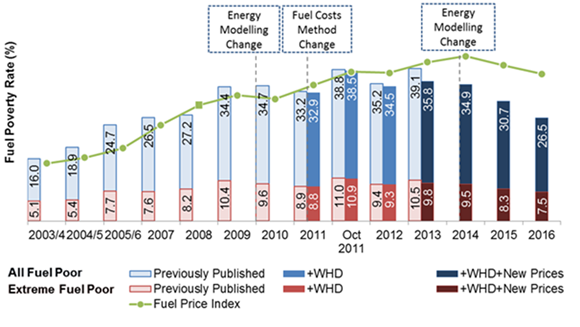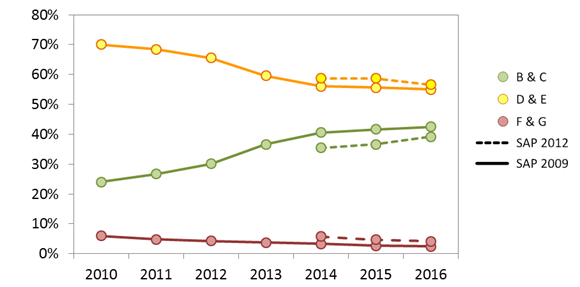Scottish House Condition Survey 2016
A National Statistics Publication for Scotland
In 2016 fuel poverty rates declined by about 4 percentage points, equivalent to 99,000 fewer households living in fuel poverty compared to 2015. 26.5% (or around 649,000 households) were fuel poor. This is the lowest rate recorded by the survey since 2005/6 and the same as in 2007. 7.5% (or 183,000 households) were living in extreme fuel poverty in 2016.
Note: WHD refers to the Warm Home Discount scheme where eligible households receive a £140 discount on their electricity bills.
Statistics on fuel poverty, energy efficiency, the condition of housing, the Scottish Housing Quality Standard (SHQS) and other key descriptors of the occupied housing stock in Scotland have been released today by Scotland’s Chief Statistician. This publication provides the first release of information from the Scottish House Condition Survey (SHCS) for the year January to December 2016.
The results from the survey show fuel poverty declining significantly for the second consecutive year.
- Almost two thirds (2.7 percentage points) of the reduction in fuel poverty rates between 2015 and 2016 can be attributed to the lower price of domestic fuels. Around a third (1.5 points) can be attributed to improvements in the energy efficiency performance of the housing stock over this period and the rest (0.1 points) can be explained by higher household incomes.
- Households using gas as the primary heating fuel saw most improvement in fuel poverty levels in the last year; less than a quarter (23%) of them are now assessed as fuel poor, down from 27% in 2015. Similarly, urban households have gained in the last year with fuel poverty levels falling 6 points to 24%. Rural fuel poverty rates have remained stable at 37% in 2016.
- Between 2015 and 2016 there has been a more noticeable decline in fuel poverty in the private sector, increasing the gap when compared to the social sector. Fuel poverty rates in the private sector have reduced from 30% to 25% while the rate in the social sector has remained at around 32% in 2016.
- Almost half (47%) of fuel poor households have incomes above the poverty threshold, defined as £291 per week before housing costs for a couple without children. This is similar to 2015. Fuel poverty rates have declined for households living above the income poverty threshold, from 20% in 2015 to 15% in 2016. The rate for households below the income poverty threshold was 78% in 2016, similar to 2015.
- Fuel poor households are more likely to report difficulties staying warm in winter. 23% of them say that their heating keeps them warm in winter “only sometimes” (16%) or “never” (7%), compared to 16% of all other households. The proportion for Scotland as a whole, 18%, fell 5 points from 2015 and is now at the lowest level since 2007. 6% of fuel poor households report that they cannot afford to heat their home, a reduction of 3 points from 2015.
The survey shows that the long-term trend in the energy efficiency of the housing stock continues to improve, while change in the last couple of years are less evident
- In 2016 39% of Scottish homes were in the highest energy efficiency bands, C or better, and half had an energy efficiency rating of 66 or higher (SAP 2012). This is a significant increase from 35% in 2014, the first year in which data based on SAP 2012 is available, although the increase since 2015 is within the margin of error of the survey results.
- In the last year, the share of older properties (1919-1944) and properties built between 1965 and 1982, in band C or better, increased by 8 percentage points to 31% and 37% respectively.
Proportion of the Scottish homes by grouped EPC Band under SAP 2009 and SAP 2012, 2010-2016
- Using SAP 2009 shows strong improvement in the energy efficiency profile of housing. The share of the most energy efficient dwellings (rated C or better) increased from 24% in 2010 to 43% in 2016. In the same period, the proportion of properties in the lowest EPC bands (E, F or G) almost halved, reducing from 27% to 14%.
- The share of homes with lofts insulated to 100 mm or more was 94% in 2016 which is similar to 2015. This represents an increase of 12 percentage points on 2010 levels. 30% of lofts had a high standard of insulation (300 mm or more), a similar level to 2015 following significant increases from 5% in 2010.
- Levels of wall insulation remained similar to 2015, with 15% of solid wall dwellings and 72% of cavity wall dwellings having insulation in 2016. However, the data demonstrates a long-term trend of improvement in the insulation of cavity walls, with the proportion increasing by 6 points since 2012. Wall insulation measures continue to be delivered under energy efficiency programmes such as ECO and the SHCS data suggests that this is having an impact, although sample size limitations mean the difference in the last year is not statistically significant.
Levels of disrepair improve, while other housing quality indicators remain stable at 2015 levels
- The level of disrepair reduced by 5 percentage points in the last year. In 2016, 68% of all dwellings had some degree of disrepair, however minor, down from 73% in 2015. Disrepair to critical elements stood at 48%, while 28% of dwellings had some instances of urgent disrepair, and in 6% of the housing stock some extensive disrepair was present. These also all represent improvements compared to 2015.
- Levels of damp and condensation remained similar to 2015. Around 9 out of 10 properties (89%) were free from any damp or condensation.
- The SHQS failure rate in the social sector was 38%, not allowing for abeyances and exemptions which are taken into account by the Scottish Housing Regulator. This has fallen from 60% in 2010. 26% of social homes did not meet the Energy Efficient criterion.
- SHCS surveyors may not always be able to identify the presence of cavity wall insulation. The overall SHQS failure rate in the social sector would be 26% if it is assumed that all social dwellings have insulated cavity walls where this is technically feasible.
- The majority of dwellings falling below the SHQS failed on a single criterion; this accounts for more than 8 out of 10 failures in the social sector. For 7 out of 10 social homes which failed the SHQS this was due to falling short on a single one of the 55 elements making up the standard.
- Compliance with the tolerable standard in 2016 remained similar to 2015: 2% (or 39,000) of all dwellings fell below the tolerable standard. This represents an improvement of nearly 2 percentage points since 2012.
- Overcrowding levels in Scotland remain unchanged: 3% of all households (67,000) were living in overcrowded accommodation in 2016.
Background
The full statistical publication can be accessed online.
The Scottish House Condition Survey is a sample survey, hence all figures are subject to a degree of uncertainty due to sampling variability. It is a two-part survey combining both an interview with occupants and a physical inspection of dwellings. The sample size in 2016 was 2,850 dwellings where both an interview and a physical survey were conducted.
Local Authority tables giving breakdowns of key SHCS measures will be published in February 2018. Local Authority estimates use combined data over the three year survey period (2014-2016), in order to obtain suitable sample sizes.
Statistics from the SHCS are used for a variety of purposes including:
- To monitor changes in the condition of the Scottish housing stock.
- To monitor commitments to eradicate fuel poverty as far as possible by 2016 as set out in the Scottish Fuel Poverty Statement 2002, and to provide evidence of types of households vulnerable to fuel poverty.
- To monitor commitments for all social sector landlords to ensure that all of their dwellings pass the Scottish Housing Quality Standard by 2015.
- To monitor commitments to improve the energy efficiency of the Scottish housing stock to contribute to the reduction of emissions as set out in the Climate Change (Scotland) Act, 2009.
- To monitor progress on Housing and Regeneration Outcome Indicators.
- To support policy development on energy efficiency standards in the social sector (EESSH) and the private sector (REEPS); help target programmes such as Home Energy Efficiency Programmes Scotland (HEEPS) and ECO on the most vulnerable households.
The Scottish Government is currently consulting on a new Fuel Poverty Strategy for Scotland, including a proposed new definition of fuel poverty based on advice from an independent panel of experts. The data presented in this report is based on the current definition.
Further information on Housing and Regeneration statistics within Scotland can be accessed online.
National statistics are produced by professionally independent statistical staff – more information on the standards of National statistics in Scotland can be accessed online.
There is a problem
Thanks for your feedback

